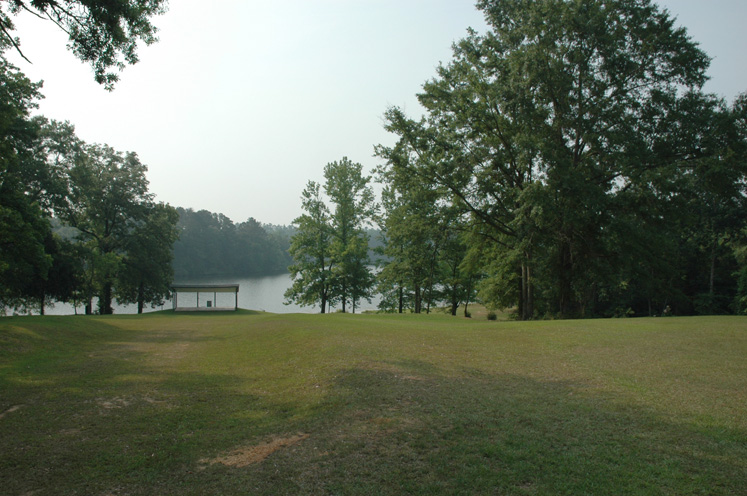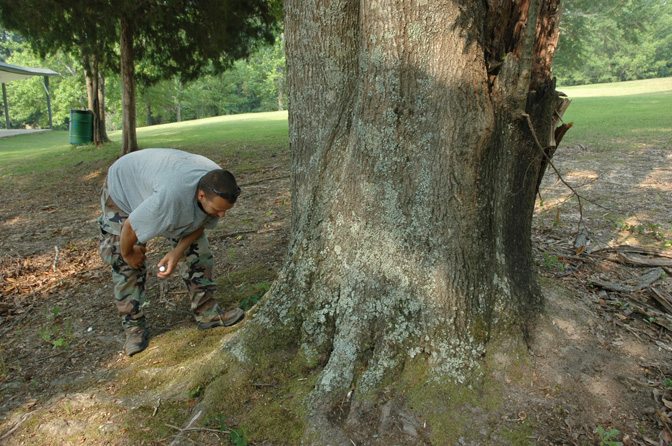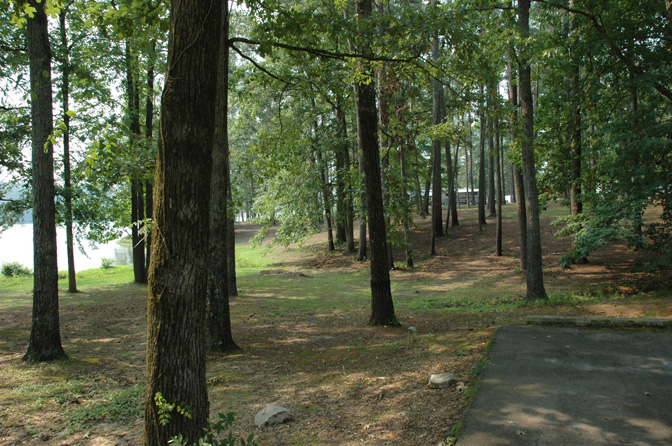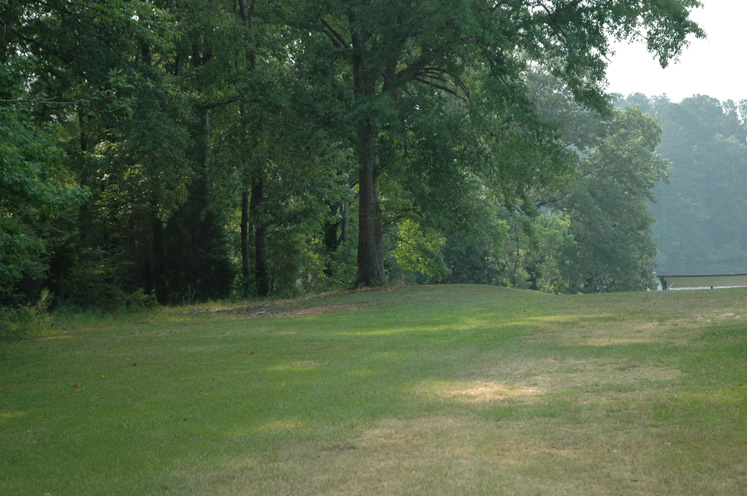Ants in Lake Lowndes State Park, Lowndes County, Mississippi, 1 June 2006 [MS State Park Ants]
Joe A. MacGown and JoVonn G. Hill
Lake Lowndes State Park is located in Lowndes County, Mississippi and is approximately eight miles southeast of Columbus on Highway 69. This 751 acre park is centered around a 150 acre lake. It has both cabin and camping areas, a 3.5 mile nature trail, playing fields, and various other amenities. The woods in the park are primarily mixed loblolly and hardwood.

View from behind the office of Lake Lowndes.
We got an early start on the day and arrived just after 8:00 A.M. We first went into the office to see if we could find the manager, Steve Hunter, and make sure that it was okay for us to collect ants. Of course, he had no problem with that. In fact, he said the park was having a serious problem with ants and wanted to know what kind they were and how to get rid of them in an environmentally sound manner. We told him we would check out the situation and tell him what kind of ants they were. We figured, based on comments he made about their abundance, that they were probably the exotic and notoriously abundant Argentine ant, Linepithema humile (Mayr). We soon found out that we were correct in our guess
After grabbing a map of the park, we went out to collect some ants. We started our collections immediately outside of the office beside the sidewalk, in the dirt next to the building, and in the front lawn (33°26'05'N 88°18'04"W). As soon as we walked outside the door and looked down we saw ants. Although it was quite obvious that they must have used some type of poison for fire ant control, we found plenty of hybrid fire ants, Solenopsis invicta X richteri, right along side the sidewalk nesting in the soil under the overhanging Liriope (monkey grass). Also roaming around the same area freely with the fire ants were several other species of ants including Dorymyrmex bureni (Trager), Forelius mccooki (McCook), Brachymyrmex patagonicus Mayr, and Monomorium minimum (Buckley). The Brachymyrmex was a bit of a surprise, as we generally see this species farther south in Mississippi, although we have found it in Starkville and one other northern locality thus far. It is another introduced species that appears to be spreading throughout Mississippi. In some of the southern counties it is very common and is becoming a nuisance pest in some homes and businesses. On the other side of the side walk, in the grassy area, we found these species and Linepithema humile (Argentine ants), Pheidole bicarinata Mayr, and Trachymyrmex septentrionalis (McCook), all nesting in the soil. The Argentine ants were nesting in the soil beside the Liriope border, whereas the other two species had nests in bare areas in the grass. Looking in the mulched border surrounding the building we found fire ants, Argentine ants, and a multitude of the Brachymyrmex.

Fire ant colony under monkey grass beside sidewalk.
We continued walking around the building and found many of the distinctive domed crater-like mounds of Dorymyrmex bureni in sandy bare patches of ground behind the office building. Upon further inspection, we noticed that the outside of the mounds were littered with bodies of Solenopsis invicta X richteri alates. Most of the bodies were female, with a few males interspersed and they were quite fresh. They all appeared to have had their legs removed. More bodies of the alate fire ants were scattered around the ground surrounding the colony area. In the pile of fire ant bodies, we observed workers of the thief ant, Solenopsis carolinensis Forel, moving freely. We also noticed that there were no obvious fire ant colonies in the immediate vicinity of the Dorymyrmex colonies. We joked that all people needed to do to get rid of fire ants was to pour some sand in their yard and dump a bunch of Dorymyrmex queens out.
In the same general area in bare patches of soil in the grass, we found many colonies of Pheidole bicarinata and a lesser number of Forelius mccooki. There were also quite a few Trachymyrmex colonies present, with most of them being found closer to the forest edge in somewhat shady areas. We found a colony of Formica pallidefulva Latreille. in the soil under a dry piece of wood approximately 0.5 m long and 0.25 m wide. We removed soil from the colony by scraping a trowel back and forth. We only had to go a couple of centimeters before we had hordes of workers rushing out. There was both larvae and cocoons present in several chambers. We kept digging hoping to find some adult and larval Cremastocheilus spp. scarab beetles, which we have found before, but had no luck. We also hoped to find some of the slave making Polyergus ants, but they were absent as well. A lepidopterous pupa was found at the edge of the colony area, but we were not sure that it was in the nest itself. The pupa emerged a few days later and was identified as a geometrid moth. In one chamber of the colony there was a midden pile of various insect parts and we saw at least two Camponotus castaneus (Latreille) heads there. Only one other worker of this reddish colored carpenter ant was collected in the area.

JoVonn collecting at large oak behind the office.
A colony of Aphaenogaster fulva Roger was found in the soil beneath a rotting piece of wood on the ground. We saw many workers of Crematogaster ashmeadi Mayr crawling on the ground at the base of a Quercus sp. tree and on the tree itself. Two carpenter ant species, Camponotus snellingi Bolton and Camponotus chromaiodes Bolton, were seen crawling on the ground and on tree trunks. Several workers of Paratrechina vividula (Nylander) were collected at bases of trees, where they were presumably nesting in the soil. One minor worker of Pheidole tetra ? Creighton was collected roaming around the ground. Unfortunately, the colony was not found and no major workers were located. This species is more reliably identified by examining the majors and that is why the species has a question mark following it. As we were leaving the area to go investigate the camping area, we walked by an ash tree, which we looked at to see if we could find any of the cool arboreal nesting Colobopsis mississippiensis (Smith). Indeed, we saw a couple of minor workers crawling on a branch. Excited, we pull a limb down to see if we could find an entrance hole, which we did. We split open the small limb, which was only about 2 cm in diameter, and found a colony with minor and major workers, alate females and males, and brood.
We next went over to the RV camping area at 33°25'35"N 88°18'14"W to see if the Argentine ants were as bad as the manager had stated. As there were quite a few campers present, we tried to be as unobtrusive as possible and parked in one of the few empty camp sites. It only took a couple of moments for us to ascertain the severity of the situation. Argentine ants were everywhere. As we walked along randomly kicking up soil from beside the road and at tree bases, the ants poured out of the ground in great numbers. The brood was usually only a couple of centimeters below the surface and multiple dealate queens were seen in colonies. The trees, similar to the ground, were covered with the ants. We watched as some Argentine ant workers attacked an alate fire ant queen. While we were looking at the ants, a lady and her small dog stopped by to see what were doing. After telling her that were surveying for ants, she told us that by spraying their campsite with some sort of poison, they seemed to be able to keep the ants from entering the RV. She also said that others had recommended that they lay trails of AJAX cleaning powder around the campsite and RV and that would supposedly keep the ants at bay. I don't know if it worked, but I guess it couldn't hurt.

The campground.
We only stayed at the camping area for a few minutes, then we went to the nature trail, which is on the opposite side of the lake. To get to the nature trail we had to walk across the levee and then through an open sandy area before finally getting into some nicer mixed forest habitat. Along the trail on the levee we saw numerous Dorymyrmex bureni colonies and a few scattered fire ant colonies. Any larger mounds we saw appeared to be inactive and we assumed that they had been poisoned. In the open sandy area past the levee, the only ants we saw were Forelius mccooki, and we saw loads of them. We then walked into the woods for a while, where we got a lat/long reading (33°25'28"N 88°17'52"W).
Ant collecting in the woods was a huge disappointment because the trail and surrounding forest was inundated with Argentine ants. We walked close to a mile along the trail, and it was much the same everywhere-Argentine ants. Similar to the camping area, all we had to do was randomly kick some soil and hordes the ants came boiling out. Walking off the trail into the woods didn't really help either. Looking under bark of dead and live trees gave us the same results, and they were seen in great numbers crawling up and down trees. Because of the extremely high numbers of these ants present, we decided not to take any litter samples from this area. We did actually collect a few other species of ants, however. A patch of hollow herbaceous stems was discovered in a small opening in the woods that was found to have ant colonies in them. The plants were dry and devoid of leaves and were probably left over from the year before, but they looked like some type of Eupatorium species.The diameter of the stems of the plants was approximately 2 cm. Breaking open some of these stems yielded two species of ants, Camponotus snellingi and Temnothorax curvispinosus Mayr. The Camponotus were only found in one stem, whereas many different stems had colonies of Temnothorax in them. Colonies of T. curvispinosus had alate females present in the colonies, as well as multiple dealate females and many variously sized workers. Only two other species of ants were collected in this area, Ponera pennsylvanica Buckley and Paratrechina faisonensis (Forel), both of which were found living in soil and leaf litter.
Because of the low diversity of ants we saw in the woods along the nature trail, we decided to go back to collect in a patch of forest near the main office that bordered the lake. We had good luck collecting near the office and hoped that the lower abundance of Argentine ants exhibited there extended into the woods. Fortunately, it turned out that there were few Argentine ant present in the wooded area, which boded well for us. Additionally, there was lots of accumulated leaf litter and many rotting logs on the ground, ideal habitat for many ant species. We soon came to the realization that this area had much more ant diversity than the forest across the lake. In rotting pine logs, we found several colonies of Pheidole dentata Mayr and Aphaenogaster fulva, as well as a colony of Camponotus chromaiodes Bolton. The Pheidole colonies were typically found under bark of the logs and were quite large with many individuals present. Upon being disturbed, the major workers were aggressive and crawled onto our skin attempting to bite us. The larger sized Aphaenogaster were less aggressive and concerned themselves with making a hasty retreat. The Camponotus colony was farther into the rotting wood and was fairly small, with only a dealate queen and a few workers seen.

The grassy area behind the office with the forest we collected in to the left.
We found Lasius americanus Emery and Paratrechina faisonensis in abundance nesting at bases of trees and near rotting logs in this patch of woods. The Lasius nests were in the soil just below the leaf litter layer, whereas the Paratrechina colonies were usually located in between layers of leaves, rather than in soil. Ponera pennsylvanica Buckley was another abundant species found in the soil and litter in the woods. A colony of this species was also found under bark at the base of a loblolly pine tree (Pinus taeda Linnnaeus). Several workers of the black carpenter ant, Camponotus pennsylvanicus (DeGeer), were seen and collected in this same area.
Since the ant collecting was so much better in this area than elsewhere, we collected six gallon sized bags of litter to take back to the lab and put into Berlese funnels. We had pretty good luck with the litter samples and collected 20 species with this method. All of the species we collected by hand in the wooded area were present in the litter samples as were several additional species including Hypoponera opacior (Forel), Discothyrea testacea Roger, Strumigenys laevinasis Smith, Strumigenys ornata Mayr, Strumigenys louisianae Roger, Solenopsis carolinensis Forel, Myrmica punctiventris Roger, Aphaenogaster carolinensis (Wheeler), and Myrmecina americana Emery. Of those species, the first five are minute, and litter sampling is the easiest way to collect them. Discothyrea testacea is a very unusual, minute species that is only somewhat rarely collected and was only recently reported to occur in Mississippi (MacGown and Brown, 2006). The three Strumigenys species are also very unusual litter dwelling ants belonging to the tribe Dacetini. They are specialized predators of various species of Collembola and other small organisms and have structural modifications in the form of modified and often bizarre setation, elongate mandibles, and spongiform tissue, all which aid them in their predatory habits. Strumigenys laevinasis appears to be less common in Mississippi and we have only collected a small number of this species in the state, whereas the other two dacetines collected are ubiquitous throughout the region and we often find them in a variety of wooded habitats. The only other species collected in the litter that could be remotely considered to be rare is Myrmica punctiventris, which was also only recently added to the list of ants from Mississippi (MacGown and Brown, 2006).
At about 2:00 P.M. we called it quits and went back to the lab. Our overall impression of the area was that the ant diversity was low, due to the extreme numbers of Argentine ants present. However, at least in the area near the office, we found ant diversity to be at a more reasonable manner, with typical populations of native ants present and we collected a total of 34 species. Three species of introduced ants were seen at the park including Linepithema humile (Argentine ants), Brachymyrmex patagonicus, and Solenopsis invicta X richteri (fire ants). The numbers of the fire ants present was relatively low, and this was probably due to a combination of control efforts by the park staff and also by the competition from the Argentine ants and the large population of Dorymyrmex bureni in the open sandy areas. The introduced Brachymyrmex was only seen in low numbers, but this species has become very abundant in southern Mississippi and it could be a potential problem here. Most of the species collected at the park would be considered very common in Mississippi, although, we don't encounter Camponotus mississippiensis very often due to its nesting in hollow stems of white ash trees. But, this species is usually easy to find if the host tree can be found.
On June 9, 2010, a return trip was made to the park by MacGown, Hill, and James Lewis. We collected in the open wooded RV campground and surrounding mixed forest (33°25'31"N 88°18'13"W) and near the beginning of the horse trail (33°26'24"N 88°18'12"W). which began in an open gravel parking lot and continued into a pine/hardwood forest. Similar to our first trip to the park, the RV campground was over-run with Argentine ants. We also found workers of the exotic Brachymyrmex patagonicus in the area. Previously, we had only seen this species near the headquarters. The only native species we found in the area was Solenopsis carolinensis. However, once we got out of the open park-like setting of the RV campground and into the wooded area across the road, we found more native species. At the horse trail area, we found fire ants to be abundant in and around the perimeter of the gravel parking lot, but within the wooded area, we found a nice assortment of native species. One additional exotic species, Strumigenys hexamera, was discovered in the park in this area. This small dacetine species is of Asian origin and is becoming widespread throughout Mississippi. Unlike many exotic species, this one thrives in natural wooded areas, where is lives in leaf litter. Overall, we collected 29 species on this trip and added 13 species to the total known from the park including Camponotus impressus, Crematogaster lineolata, C. minutissima, C. missuriensis, Pachycondyla gilva, Prenolepis imparis, Pseudomyrmex pallidus, Strumigenys angulata, S. dietrichi, S. hexamera, S. missouriensis, S. ohioensis, and S. pulchella .
At this time we have records for 47 species of ants from the park. This total is based on only a few hours collecting, and more species are likely present. The same three exotic species, Brachymyrmex patagonicus, Linepithema humile, and Solenopsis invicta x richteri, that we collected on our first trip to the park, were still abundant, and the presence of a fourth exotic species, Strumigenys hexamera, was discovered.
List of ant species collected (arranged alphabetically by genus)
Aphaenogaster carolinensis (Wheeler)
Aphaenogaster fulva Roger
Brachymyrmex patagonicus Mayr
Camponotus castaneus (Latreille)
Camponotus chromaiodes Bolton
Camponotus nearcticus Emery
Camponotus pennsylvanicus (DeGeer)
Camponotus snellingi Bolton
Colobopsis impressa Roger
Colobopsis mississippiensis (Smith)
Crematogaster ashmeadi Mayr
Crematogaster lineolata (Say)
Crematogaster minutissima Mayr
Crematogaster missuriensis Emery
Pachycondyla gilva(Roger)
Discothyrea testacea Roger
Dorymyrmex bureni (Trager)
Forelius mccooki (McCook)
Formica pallidefulva Latreille
Hypoponera opacior (Forel)
Lasius americanus Emery
Linepithema humile (Mayr)
Monomorium minimum (Buckley)
Myrmecina americana Emery
Myrmica punctiventris Roger
Nylanderia faisonensis (Forel)
Nylanderia vividula (Nylander)
Pheidole bicarinata Mayr
Pheidole dentata Mayr
Pheidole dentigula Smith
Pheidole tetra ? Creighton
Ponera pennsylvanica Buckley
Prenolepis imparis (Say)
Pseudomyrmex pallidus (Smith)
Solenopsis carolinensis Forel
Solenopsis invicta X richteri
Strumigenys angulata Smith
Strumigenys dietrichi Smith
Strumigenys hexamera (Brown)
Strumigenys louisianae Roger
Strumigenys missouriensis Smith
Strumigenys laevinasis Smith
Strumigenys ohioensis Kennedy & Schramm
Strumigenys ornata Mayr
Strumigenys pulchella Emery
Temnothorax curvispinosus Mayr
Trachymyrmex septentrionalis (McCook)
MacGown, J. A. and R. L. Brown. 2006. Survey of Ants (Hymenoptera: Formicidae) of the Tombigbee National Forest in Mississippi. Kansas Entomological Society 79: 325-340. [pdf]


